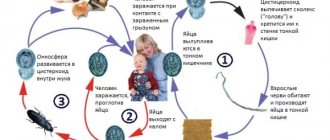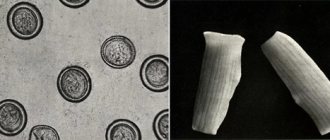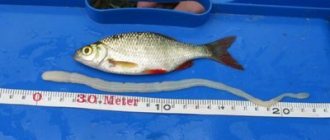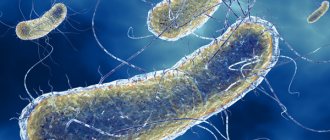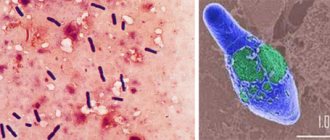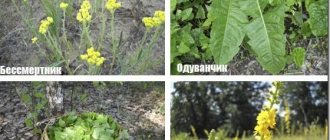The relevance of taeniasis in the Russian Federation continues to this day, despite the rather low all-Russian incidence rate. This is due to the presence of certain regions where cases of invasion continue to be recorded without a downward trend (Republic of Tyva, Kalmykia, Krasnoyarsk Territory, Ural Federal District).
Of particular importance is the prevention of infection with pork tapeworm and complications of helminthiasis, often leading to loss of ability to work and disability.
Pork tapeworm (lat. Taenia solium, armed tapeworm) is a helminth, the causative agent and cause of such human diseases as taeniasis and cysticercosis. Belongs to the class of tapeworms (Cestoda).
General information
The pig tapeworm (armed tapeworm) is a parasitic tapeworm from the cestodose group, family Taeniidae, that lives in the human intestine. Pork tapeworm causes helminthiasis, called taeniasis (Taenia solium), which is characterized by digestive disorders and astheno-neurotic symptoms. Its frequent complication is cysticercosis , which is manifested by the parasitism of pork tapeworm larvae in the tissues of the body (brain and eyes). Taeniasis is widespread in the world (countries of Latin America, Africa and Asia), including in the CIS countries (Russian Federation, Ukraine, the Republic of Belarus, the Baltic countries), mainly in areas where pig farming is widely developed. In areas where taeniasis is endemic, cysticercosis of pigs can affect 25-35% of the total population. Photo of pork tapeworm in the intestines below.
Cysticercosis of the brain can be either a complication of taeniasis or a separate form of helminthiasis . The disease occurs when pork tapeworm larvae enter the cerebral tissues of various brain structures and form cysticerci - larval vesicles with the helminth head inside. About 60% of cysticercosis is associated with brain damage. Cysticercosis of the eyes or skeletal muscles is much less common. Among the cerebral structures, the larvae are most susceptible to penetration into the cerebral membranes of the base, the surface of the cerebral cortex, and the ventricles of the brain. Widespread lesions of cysticerci in brain structures manifest with neurological symptoms (neurocysticercosis) and can cause death.
Prevention of pork tapeworm infection
Now you have an idea how to get rid of pork tapeworm.
But it is much better to prevent infection with it and do everything to prevent this disease:
- observe the rules of personal hygiene, be sure to wash your hands after using the toilet;
- purchase meat only in large or specialized stores and carefully inspect it for the presence of suspicious inclusions (which may include pork tapeworm);
- store meat in proper conditions, for long-term storage - in the freezer;
- When preparing meat dishes, carry out thorough heat treatment;
- do not taste raw minced meat when cooking;
- If suspicious symptoms appear, consult a doctor immediately.
Pathogenesis
Once in the stomach of the intermediate host (pig), the shell of the tapeworm egg is actively destroyed and the oncospheres enter the circulatory system of the gastrointestinal tract and are carried by the blood stream throughout the body. Then the oncospheres settle in the intermuscular connective tissue, where they rather turn into a cysticercus (finna). When eating contaminated meat, cysticerci attach to the human mucosa in the intestine, begin to grow and quickly reach sexual maturity (after 2-3 months). In pathogenesis, a significant role is played by:
- reactions of a toxic-allergic nature developing against the background of parasite metabolism/severe toxic effects (sensitization of the body with allergic reactions, local and general) of immediate type;
- mechanical irritation of the intestinal mucosa by the parasite’s suckers, which contributes to irritation of mechanoreceptors and impaired motility;
- secretory function disorder;
- development of the inflammatory process in the gastrointestinal tract;
- the process of absorption of nutrients in the human body.
The pathogenesis of neurocysticercosis is due to its multiple nature and is accompanied by severe symptoms, caused, first of all, by irritation of cerebral tissues at the site of parasite localization, the development of an inflammatory process, accompanied by overproduction of cerebrospinal fluid with hydrocephalus and their toxic effects.
Causes
The etiological factor of neurocysticercosis is the armed tapeworm, which is a type of tapeworm (flatworm).
Features of helminth biology
The habitat of a sexually mature pork tapeworm is the human small intestine (upper part), on the walls of which it is fixed and subsequently its nutrition is carried out at the expense of humans, absorbing nutrients osmotically. At the same time, the tapeworm mechanically irritates the intestinal mucosa and releases toxic products of the metabolic process into its lumen.
The structure of the pork tapeworm
The total length of the parasite in most cases varies within 2-3 meters, rarely reaching a greater length. The body of the helminth consists of:
- the head (scolex), on which there are 4 suckers and two rows of chitinous hooks, with the help of which the parasite is attached to the intestinal wall;
- necks and bodies (strobili) are ribbon-shaped, which is represented by flat segments, the number of which can reach 900-1000 and which periodically bud.
The pig tapeworm is a hermaphrodite. The young segments contain female/male genital organs that fertilize each other. In the mature segment there is a uterus, which is filled with fertilized eggs, the number of which varies between 30-50 thousand, and viability remains for 18 months. The segments, along with the eggs, enter the external environment during defecation. In the environment, eggs can remain viable for several months, depending on conditions: they survive in water for up to 4 months; when dry - within 10 months; when exposed to sunlight, they remain viable for about 2 days, and in grass - up to 1.5 months. When treated with bleach, the eggs die within 5-6 hours. They die almost immediately when boiled, at 65°C - within 3 minutes. Cysticerci in meat are preserved for 10 days when frozen at least -10°C and die when frozen to a meat temperature of -12°C.
After entering the digestive tract of the intermediate host, the egg shell dissolves and an oncosphere (embryo) with three pairs of hooks emerges. After oncospheres invade the intestinal wall and enter the bloodstream, they spread throughout the body and settle in soft tissues, mainly in connective tissue (between muscle fibers), where a fin (cysticerci) with a diameter of up to 1.5 cm with an adult scolex is formed .
Epidemiology
The source of infection is an infected person who excretes helminth eggs in their feces. He is also the final owner. Intermediate hosts include animals that eat food containing human feces: pigs, wild boars, dogs, monkeys, cats. In the case of ingestion of eggs excreted in human feces, humans can also act as intermediate hosts for the larvae, but such cases are extremely rare.
The fecal-oral mechanism of transmission through the food route of infection is characteristic. Transmission factors include meat infected by Finns. That is, human infection with pork tapeworm occurs when eating meat that has not undergone sufficient heat treatment. In cysticercosis, infection occurs through food contaminated with eggs or due to non-compliance with personal hygiene rules - environmental objects. Less commonly, autoinvasion acts as a transmission factor when, if a person has a tapeworm, there are disturbances in gastrointestinal motility, for example, during vomiting or with reflux disease , which leads to their entry into the stomach.
Thus, the life cycle of tapeworm development includes the change of two hosts: humans, in whose body adults live, reproducing sexually, and pigs, in whose bodies larvae live. There are two larval stages of pork tapeworm: eggs and oncosphere.
Below is a schematic diagram of the life cycle of a pork tapeworm.
Drug therapy
Two drugs have been approved by the CDC for the treatment of taeniasis: praziquantel (Biltricide) and niclosamide (Fenasal). Praziquantel is usually used in combination with an effective laxative, dosing regimen 5-10 mg/kg body weight once (in both adults and children) . A laxative is usually used two hours after taking the tablets to remove mature proglottids before eggs are released from them (prevention of cysticercosis). There are known cases of surgical removal of mature worms from the small intestine.
Niclosamide (the drug is not currently registered in the Russian Federation) is a good alternative drug for the treatment of taeniasis. The treatment regimen involves a single dose of 2 g of the drug for adults and 50 mg/kg of body weight for children.
The drug of choice for cysticercosis (especially neurocysticercosis) is albendazole in combination with glucocorticosteroids (glucocorticoids) under constant medical supervision.
A recent placebo-controlled, double-blind study demonstrated that treatment of neurocysticercosis with albendazole (400 mg twice daily plus 6 mg dexamethasone QD for 10 days) reduced the number of attacks over a subsequent 30-month follow-up (source CDC).
It is also possible to prescribe praziquantel, but its use can provoke the development of an inflammatory process and worsening of symptoms, which is especially dangerous in case of cysticercosis of the brain.
The principles of treatment of cysticercosis are being developed and improved to this day. Treatment of this complication (or independent disease) is carried out only in a hospital. Praziquantel is not prescribed for ocular cysticercosis or for pregnant women.
The use of anthelmintic drugs for calcified cysts is ineffective.
For cysticercosis of the eyes and single cysticerci of the nervous system, surgical treatment is used, in the postoperative period of which praziquantel and glucocorticosteroids are prescribed.
The effectiveness of deworming is determined by control stool examinations one to two to three months after the course of treatment.
Symptoms
Symptoms of pork tapeworm in humans can be variable, ranging from their complete absence or with nonspecific mild symptoms. In a clinically pronounced course, the disease manifests itself as astheno-neurotic, dyspeptic and abdominal syndrome. It develops on average 1.5-2 months after cysticerci enter the body.
Early clinical manifestations include: lack of appetite, nausea/vomiting, weight loss, stool disorders. Both unexpressed abdominal pain and cramping, intense pain may appear, and less commonly, anal itching. Manifestations of astheno-neurotic syndrome are: irritability , headaches , dizziness , fainting, sleep disturbances. In peripheral blood - iron deficiency anemia , eosinophilia . When cysticerci enter brain tissue, an extraintestinal form of the disease develops - neurocysticercosis .
Symptoms of cysticercosis in humans
The disease manifests itself predominantly with symptoms of irritation, manifested by symptoms of focal epilepsy with transition to status epilepticus and liquor hypertension , manifested by liquor-hypertensive crises with headache, vomiting, dizziness. The manifestation of symptoms is largely due to the size of cysticerci, the number and their location in the structures of the brain. Accordingly, loss of neurological functions can have varying severity, ranging from their absence, mild deficits or severe manifestations in the form of sensory impairments, speech disorders, paresis and epileptic seizures. Often, patients with cysticercosis of the brain have mental disorders, manifested by aggression / depression , delusions , and hallucinations .
Cysticercosis of the ventricles of the brain
When cysticerci are localized in the cerebral ventricles, the larvae float in the cerebrospinal fluid and can, with varying frequency, cause blockage of the cerebrospinal fluid outflow tract, which causes a cerebrospinal fluid-hypertensive crisis, the manifestations of which are similar to the symptoms of brain tumors of the same localization. Cysticercosis of the fourth ventricle is characterized by Bruns syndrome , manifested by severe headache and vomiting with respiratory distress and impaired cardiovascular function. The syndrome develops as a result of irritation of the fundus of the ventricle. When localized in the lateral ventricles, disturbances of consciousness are observed caused by obstruction (blockage) of the opening connecting it with the third ventricle.
Cysticercosis of the meninges
Depends on the location of the larvae. When the membrane is damaged, the symptoms of damage to the cranial nerves and meningitis with bradycardia , which is manifested by strabismus, visual disturbances and paresis of the facial nerve.
Cysticercosis of the base of the brain
Symptoms of basal meningitis , accompanied by headache, vomiting, and bradycardia. Cysticercosis of the brain is characterized by a long remitting course with long “light” periods. Spontaneous healing is impossible.
Clinical picture of taeniosis
The harmful effect of the parasite is formed from mechanical effects, consumption of the host’s food, and the toxic effect of the worm’s waste products on the human body. As a result, the signs of taeniasis can be quite diverse, but nonspecific.
The initial symptoms of invasion begin to appear in humans only in the chronic phase, when the tapeworm grows into a sexually mature individual. Patients complain of weakness, increased irritability, and appetite disorders. At the beginning of the disease, appetite increases very strongly, up to bulimia (craving to overeat), while the patient’s weight does not increase, but even decreases; over time, appetite decreases, and the person’s weight returns to normal and does not change significantly in the future.
Patients experience pain in different halves of the abdomen. Particularly common in the right iliac region, when proglottids pass through the receptor-rich ileocecal valve (Bauhinian valve), separating the small and large intestines.
Patients are concerned about nausea, vomiting, rumbling in the abdomen, flatulence (painful bloating), and periodic increased frequency of stools. Many patients complain of the presence of helminth segments in the feces. Some patients experience glossitis (inflammation of the tongue).
In persons with weakened immune systems, neurological disorders, headache, dizziness, fainting, sleep disturbances, and sometimes convulsive seizures may occur. At later stages during the life of the worm, the infected person develops allergic skin lesions in the form of urticaria.
A severe and dangerous complication of taeniasis is cysticercosis, when the Finnish stage of the helminth develops in the human body, turning the patient into an intermediate host. A person suffering from pork tapeworm is always at risk of developing cysticercosis!
Tests and diagnostics
Making a diagnosis of “cysticercosis of the brain” presents certain difficulties and includes a comprehensive examination of the patient (epidemiological information, clinical data, laboratory/instrumental diagnostic methods):
- Neurological examination. It consists of identifying symptoms of irritation and symptomatology, indicating polyfocality of damage to cerebral structures, manifestations of neurological deficit, the nature of the course and the presence of long periods of remission. The presence of focal epileptogenic activity is confirmed by electroencephalography.
- Ophthalmological examination (ophthalmoscopy). Detection of chronic intracranial hypertension (congestive optic discs); less often, cysticerci .
- Radiation methods (CT/MRI, brain X-ray), which make it possible to visualize both individual cysticerci and their clusters in the form of a bunch of grapes. X-rays of the skull reveal calcification of the cysticercus in the form of small focal shadows.
- Laboratory tests.
- Immunological methods of blood/cerebrospinal fluid testing (ELISA, RSK, RIF) to detect IgG antibodies to tapeworm cysticerci. In the blood - eosinophilia , in the cerebrospinal fluid - cytosis with a predominance of eosinophils/lymphocytes. Microscopic examination of stool to identify segments of T. solium.
Differential diagnosis is carried out with meningitis of other etiologies, epilepsy , encephalitis , intracranial tumors .
Treatment
Depending on the number of finn and their location, cysticercosis can be treated both conservatively and surgically. Conservative treatment of pork tapeworm is aimed at deworming the body, normalizing increased intracranial pressure , and in the presence of convulsive syndrome - anticonvulsant treatment.
For the purpose of deworming the body, Praziquantel / Albendazole according to a special regimen. Treatment must be carried out with caution due to the high risk of deterioration of the condition against the background of an increase in epiparoxysms, which is caused by intoxication of brain tissue with the breakdown products of cysticerci against the background of their decay. At the stage of deworming, the administration of drugs with anti-inflammatory effects, including glucocorticosteroids ( Dexamethasone , Prednisolone ), is indicated.
In order to relieve intracranial hypertension, diuretics are prescribed ( Acetazolamide , Furosemide ). In the presence of convulsive syndrome, anticonvulsant therapy is carried out, for which antiepileptic drugs are used - Diazepam , Carbamazepine , Valproic acid , etc. At the same time, symptomatic therapy is carried out.
The doctors
specialization: Parasitologist
Fedosyuk Alexander Vasilievich
8 reviewsSign up
Find a doctor and make an appointment
Medicines
Praziquantel
Dexamethasone
Prednisolone
Acetazolamide
Furosemide
Diazepam
Carbamazepine
Valproic acid
- Preparations for dehydration of the body ( Praziquantel , Albendazole ).
- Glucocorticosteroids ( Dexamethasone , Prednisolone ).
- Diuretics ( Acetazolamide , Furosemide ).
- Antiepileptic drugs ( Diazepam , Carbamazepine , Valproic acid ).
Procedures and operations
Surgical treatment of neurocysticercosis is performed relatively rarely, mainly in cases of detection of single finns, which are located in the ventricles/base of the brain and do not respond to antiparasitic drugs. In case of internal hydrocephalus , ventriculoperitoneal shunting is performed.
What is the difference between bovine tapeworm and pork tapeworm?
Although the size of the pork tapeworm is smaller than that of the bovine tapeworm (it reaches up to 10 m), the pork tapeworm is more dangerous due to its hooks - the bovine tapeworm does not have them.
Although the eggs of both parasites are similar in appearance, in the pork tapeworm they are infectious to humans, but in the bovine tapeworm they are not.
The main way to distinguish these parasites in the laboratory is by the end segments, which are elongated in the pork tapeworm; in addition, they have an ovary with a third (accessory) lobule.
Laboratory analysis is necessary to select treatment tactics, since there are differences depending on the type of parasite.
Diet
Diet for worms
- Efficacy: healing effect
- Terms: 21-30 days
- Cost of products: 1300-1400 rubles per week
Dietary nutrition is not used in the treatment of neurocysticercosis. The indication for prescribing a diet for worms is only the period of deworming. It is recommended to limit/exclude from the diet fatty foods (meat, fish, animal fats), as well as foods that cause rotting/fermentation processes in the intestines (milk/dairy products, baked goods, sweets, honey, jelly, sugar, jam, puddings, cakes , white rice, sweet fruits/dried fruits, dairy cheeses, ice cream).
It is also necessary to minimize the intake of products into the body that contain food additives, especially preservatives, sweeteners, flavor enhancers and various dyes, coffee, coarse fiber and any alcohol.
The diet should contain vegetables/fruits (white cabbage, sea cabbage, Brussels sprouts, cauliflower, onions, zucchini, beets, garlic, pumpkin, carrots, watercress, spinach) in any form (baked, boiled, fresh).
Particularly beneficial is the consumption of various cereals, jacket potatoes, unsweetened fermented milk products, low-fat cottage cheese, mushrooms, various virgin vegetable oils, various seeds/nuts, especially raw pumpkin seeds, flax seeds, and milk thistle. Drinks include rosehip decoction, vegetable juices, unsweetened green tea, non-carbonated mineral water in a volume of at least 2-2.5 liters per day.
It is possible to defeat parasites!
Antiparasitic Complex® - Reliable and safe removal of parasites in 21 days!
- The composition includes only natural ingredients;
- Does not cause side effects;
- Absolutely safe;
- Protects the liver, heart, lungs, stomach, skin from parasites;
- Removes waste products of parasites from the body.
- Effectively destroys most types of helminths in 21 days.
There is now a preferential program for free packaging. Read expert opinion.
Read further:
Pork roundworm: description and structure, life cycle and ways to remove it
Parasites in lard: what worms can be in pork lard
Coenurosis of sheep, dogs, pigs and other animals: symptoms and treatment
Bovine tapeworm - treatment and control of bovine tapeworm, what methods and medications to use
Who is the intermediate and main host of the bovine tapeworm?
Canine tapeworm: routes of infection, life cycle and treatment methods
List of sources
- Cherkassky B.L. Infectious and parasitic diseases of humans. Epidemiologist's Handbook. - M., 1994.
- SanPiN 3.2.3215-14 “Prevention of parasitic diseases on the territory of the Russian Federation” dated August 22, 2014 No. 50 (as amended on December 29, 2015).
- Parasitology and invasive diseases of farm animals / K. I. Abuladze, N. V. Demidov, A. A. Nepoklonov, S. N. Nikolsky, N. V. Pavlova, A. V. Stepanov. Ed. K. I. Abuladze. - M.: Agropromizdat, 1990.
- Parasitic diseases of humans (protozoa and helminthiasis) / ed. V. P. Sergieva, Yu. V. Lobzina, S. S. Kozlova. - St. Petersburg: Foliot, 2016. - pp. 373-382.
- Kalenova, L. F. Some biological patterns of formation of the “parasite-host” system / L. F. Kalenova // Medical parasitology and parasitic diseases. 2009. No. 3. P. 16 – human helminthiasis: Epidemiology and control / F. F. Soprunov, E. S. Shulman, E. S. Leikina and others. Ed. F. F. Soprunova. - M.: Medicine, 1985.
